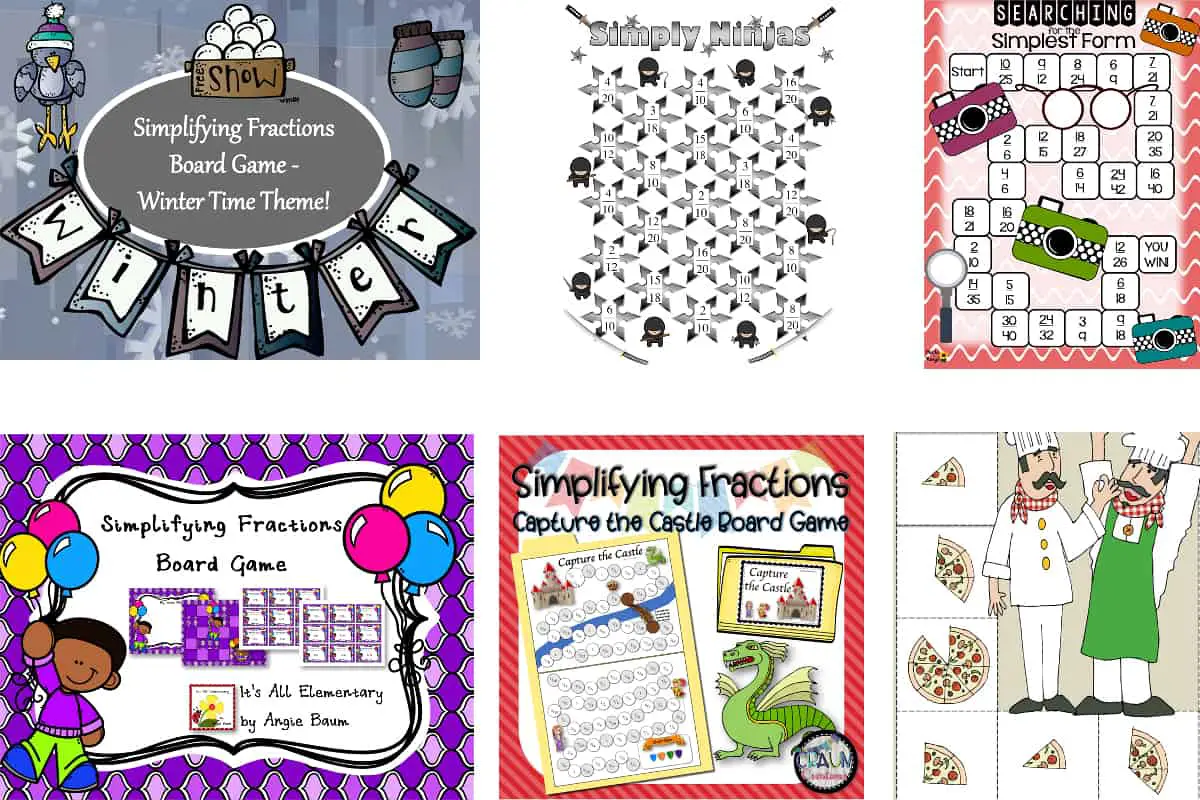This post contains affiliate links.
Board games for identifying or simplifying fractions provide a fun way for teachers and parents to help children master these fundamental fraction skills. Children who don’t master how to identify and simplify fractions also grapple with basic operations with fractions.
I found 7 useful printable fraction board games for identifying & simplifying fractions. They are designed for small group classroom settings but can also be used at home. I highly recommend Capture the Castle by Kathryn Craun.
Printable Fraction Board Games Comparison Table
I have created the table below to make it easier for you to choose the game that works best for your students or children.
| Game | Grade | Players | Price | For | Rating |
|---|---|---|---|---|---|
| Pizzeria Pieces | K to 1 | 2‑4 | $ | Teachers, families | ★★★☆☆ |
| Simplifying Fractions – Wintertime Theme | 2-4 | 2 | $ | Teachers | ★★★☆☆ |
| Identifying Fractions | 3‑4 | 2‑4 | $ | Teachers, families | ★★★☆☆ |
| Searching for the Simplest Form | 3‑6 | 2 | $ | Teachers | ★★★☆☆ |
| Simplifying Fractions (Angie Baum) | 3-5 | 2‑4 | $ | Teachers | ★★★☆☆ |
| Simplifying Fractions – Capture the Castle | 4‑6 | 2‑4 | $ | Teachers | ★★★★☆ |
| Simply Ninjas | 4-6 | 2 | $ | Teachers | ★★★☆☆ |
Printable Fraction Board Games for Kindergarten
Pizzeria Pieces (Brainiac Education)
★★★☆☆
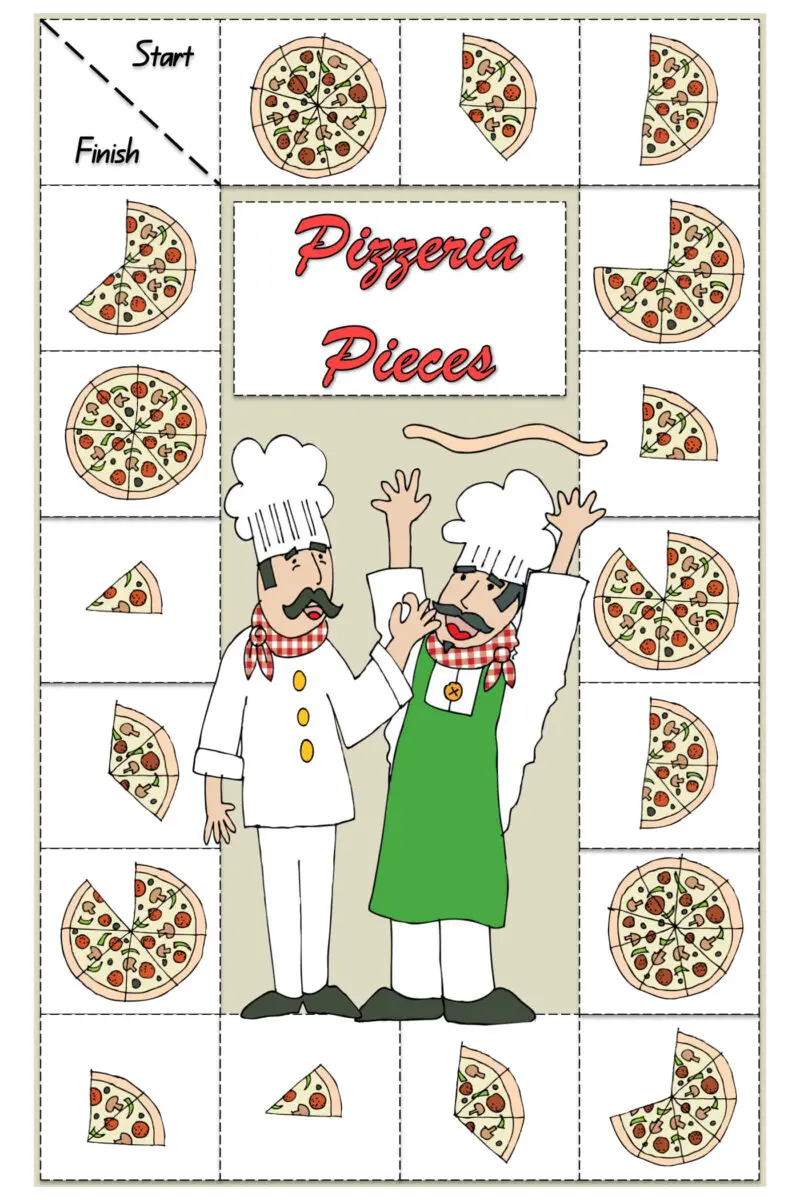
Players: 2-4 | Age: 5-7 | CCSS Grade: Kindergarten to Grade 1
The Pizzeria Pieces factions game has four great features:
has four great features:
- It is colorful.
- It is related to something children love to eat – pizza.
- It only has one page, which is great when you need to print multiple copies.
- The instructions are short, easy to understand, and clearly presented on the game board.
Children at the K2 and grade one levels will have fun moving around the game board and identifying the fractions represented. You can only hope that they won’t be begging for pizza by the time they’re done! However, there are only 17 questions which means that children may finish the game quickly.
Printable Fraction Board Games for Primary School
Identifying Fractions (Chloe Campbell)
★★★☆☆
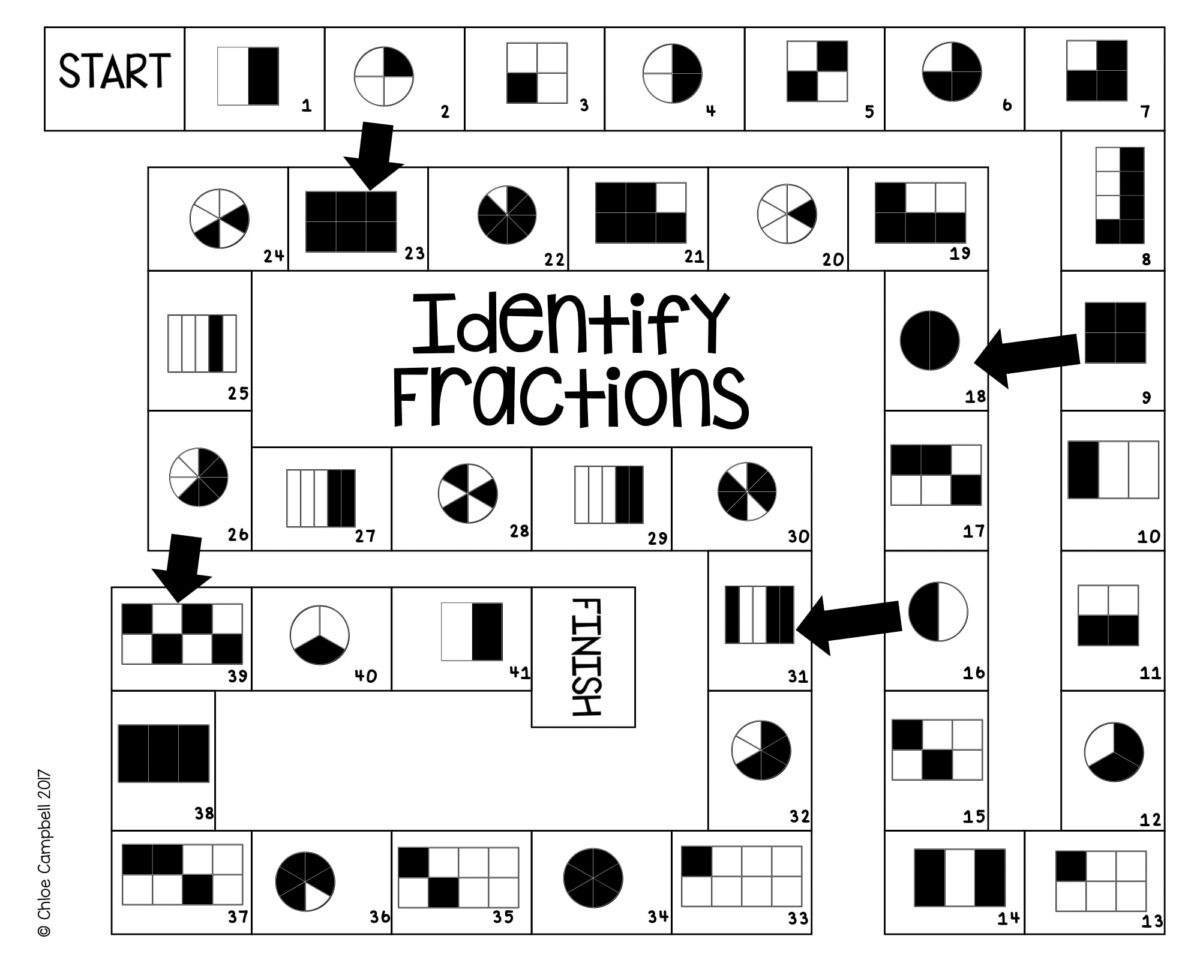
Players: 2-4 | Age: 7-10 | CCSS Grade: 3-4
This simple identifying fractions game is good for children who are just being introduced to more abstract representations of fractions. Brainiac Education’s Pizzeria Pieces game is more colorful and applicable to real-life in a way that children at the kindergarten level would understand and appreciate. Chloe Campbell’s game, however, is better suited for children in grades three or four who are about to be introduced to other fraction concepts such as equivalent fractions and adding and subtracting fractions.
is good for children who are just being introduced to more abstract representations of fractions. Brainiac Education’s Pizzeria Pieces game is more colorful and applicable to real-life in a way that children at the kindergarten level would understand and appreciate. Chloe Campbell’s game, however, is better suited for children in grades three or four who are about to be introduced to other fraction concepts such as equivalent fractions and adding and subtracting fractions.
Players take turns rolling dice and then moving the number of spaces thrown. Each player would then write on the answer key the fraction that represents the image. All players check their answers and, if all answers are the same, the player stays on the space and the next player rolls the dice. If all answers aren’t the same, players should discuss with each other and come up with the correct solution.
The beauty of this strategy is that it encourages peer discussions. Students can check each other’s work and help their peers in ways a teacher or parent probably couldn’t. However, what happens when everyone has an incorrect answer? How do players even really know their answers are correct without looking at the answer key and seeing the answers for all the questions?
Those two drawbacks mean that it may be necessary to have an additional player who serves as the answer checker. If this game is being played at home, the parent can be the answer checker. Otherwise, the answer checker has to be another student. Therefore, this student would not experience the benefits of being fully involved in the game like the other players.
Another drawback of this game is the fact that it’s black and white. This color combination makes it difficult to see the partition lines in some of the images. Therefore, it may be difficult to correctly identify some of the fractions.
Nevertheless, there is another plus for this game. There are 41 questions which means that students won’t finish as quickly as they would in the Pizzeria Pieces Fractions game, especially if there are only two players.
Searching for the Simplest Form (Meryl)
★★★☆☆
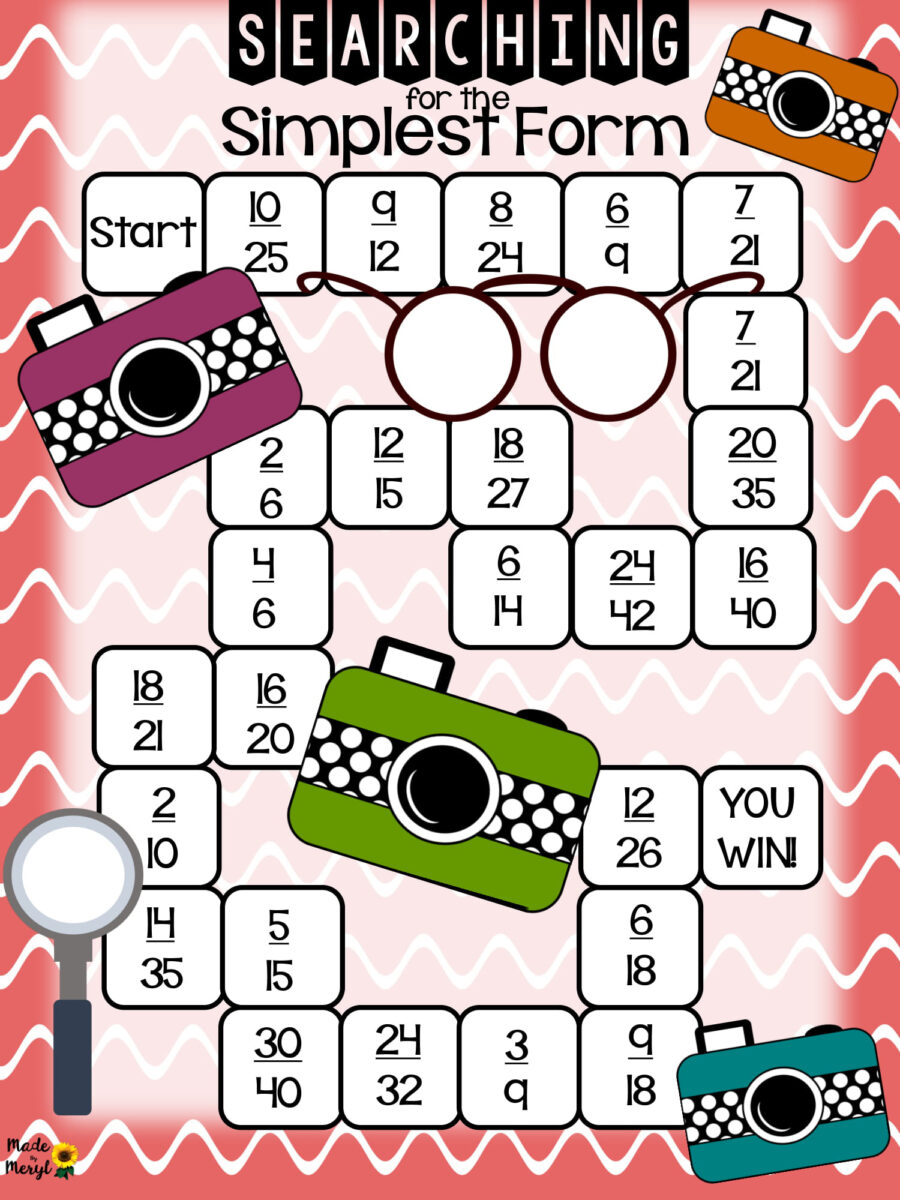
Players: 2 | Age: 8-12 | CCSS Grade: 3-6
Searcing for the Simplest Form helps students get practice with simplifying fractions using factors ranging from 2 to 10. It isn’t a game that I would recommend for parents to use at home if they are not good with fractions because there isn’t an answer key that you can use to verify your child’s answers.
helps students get practice with simplifying fractions using factors ranging from 2 to 10. It isn’t a game that I would recommend for parents to use at home if they are not good with fractions because there isn’t an answer key that you can use to verify your child’s answers.
The eye-catching game board is likely to grab the students’ attention. However, the fractions may not be difficult enough for a child at the grade six level. It would have been great if some fractions were included that required the use of factors greater than 10. That would have forced players to think a bit more carefully about how to find their answers.
Interestingly, one of the benefits of this simplifying fractions board game is also its downfall. The game board has a lot of colors and would, therefore, require a lot of ink. Imagine printing a set of these for a class with 30 students. That’s 15 copies!
Furthermore, not having an answer key means that students can’t check their work independently. This may result in the teacher being pulled in multiple directions as groups try to determine if their answers are correct. Answer key cards (where the answers are separated into individual cards rather than a full sheet) would be a great addition so that students can check their work without seeing all the answers simultaneously.
Simplifying Fractions (Angie Baum)
★★★☆☆
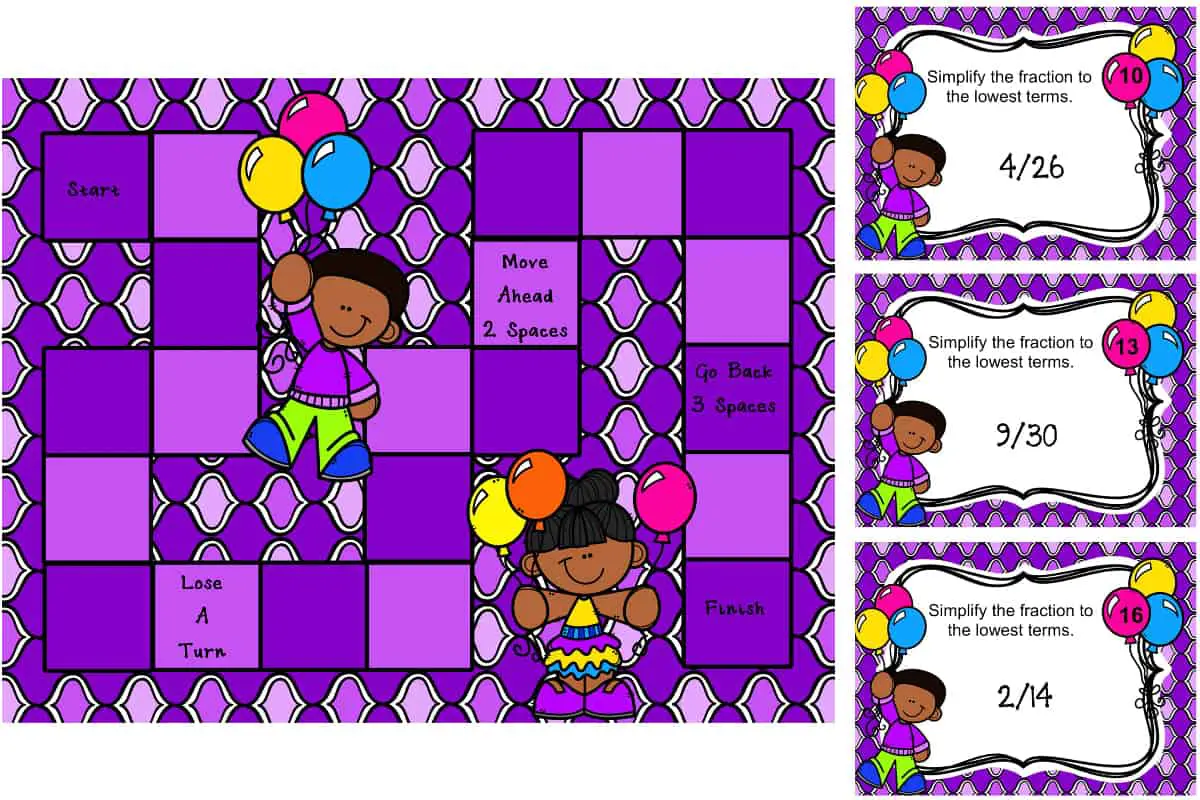
Players: 2-4 | Age: 8-11 | CCSS Grade: 3-5
Simplifying fractions by Angie Baum another colorful simplifying fractions board game that helps children practice simplifying fractions using factors ranging from 2 to 11.
another colorful simplifying fractions board game that helps children practice simplifying fractions using factors ranging from 2 to 11.
What sets this game apart from Meryl’s Searching for the Simplest Form game is that there are a few outliers, such as 18/36, that a more advanced student may realize requires a factor greater than 11. Although a student can use smaller numbers such as 2, 3, or 9 to simplify that fraction, a quick thinker would realize that the best factor to use is 18. Therefore, a teacher can use this game to further identify students who are great at the topic and use these students for peer mentorship.
There are also some wild cards that add another layer of interest to the game. For instance, the “Trade Places with Another Player” card may create bursts of excitement as players try to switch places with those closer to the finish line. Angie has also left four of these wild cards blank so that you can create your own fun prompts.
However, there are a few drawbacks to this game. Firstly, the space given for students to write their answers (the work mat) may be too small for children with large handwriting. It would be better to use blank sheets of paper or folder leaves for rough work.
Additionally, there are eight pages of content that need to be printed. All pages are very colorful and, therefore, use a lot of ink. This game really isn’t printer-friendly, but children will love the bright colors.
Finally, the answer key is on a single sheet. This may mean that another student who isn’t playing the game would need to be the answer checker. This student would miss out on the benefits of engaging in the game.
Simplifying Fractions – Capture the Castle (Kathryn Craun)
★★★★☆
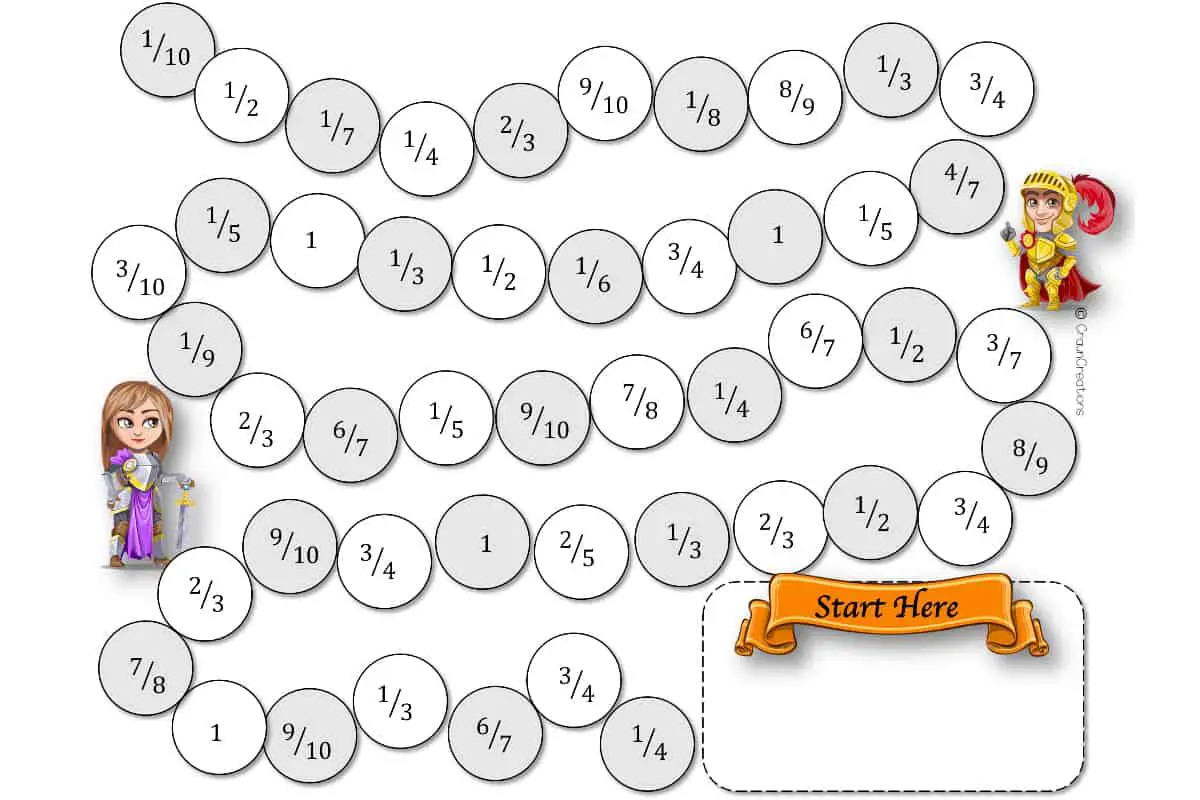
Players: 2-4 | Age: 9-12 | CCSS Grade: 4-6
Details matter in this simplifying fractions board game . Kathryn has included a video tutorial that explains the game’s three levels of difficulty:
. Kathryn has included a video tutorial that explains the game’s three levels of difficulty:
- Level one: students are given a hint sheet that indicates which fractions are not yet in their simplest form and equivalent fractions.
- Level two: includes a hint sheet that only tells students which fractions are not in their simplest form.
- Final level (the most difficult): doesn’t include a hint sheet.
Additionally, regular playing cards are used for this game. Therefore, teachers and students don’t have to spend several minutes cutting out printed game cards. Using playing cards creates a random element to the game that forces students to think.
Face cards also have value. An Ace represents 1, a Jack represents 12 and a King or Queen gives the player the option to switch positions with another player.
One of the limitations of using playing cards, however, is that the highest denominator students will get is 12. Students at the grade 6 level can benefit greatly from practicing simplifying fractions with much larger denominators.
Nevertheless, it’s likely that students will be playing this game for more than 15 minutes if the teacher chooses to use the long game board. Therefore, this game would be a great culminating activity for a lesson on simplifying fractions. The teacher would need to provide additional activities though for more advanced students who finish earlier than expected.
Simplifying Fractions Board Game Wintertime Theme (PowerPoint Maniac)
★★★☆☆
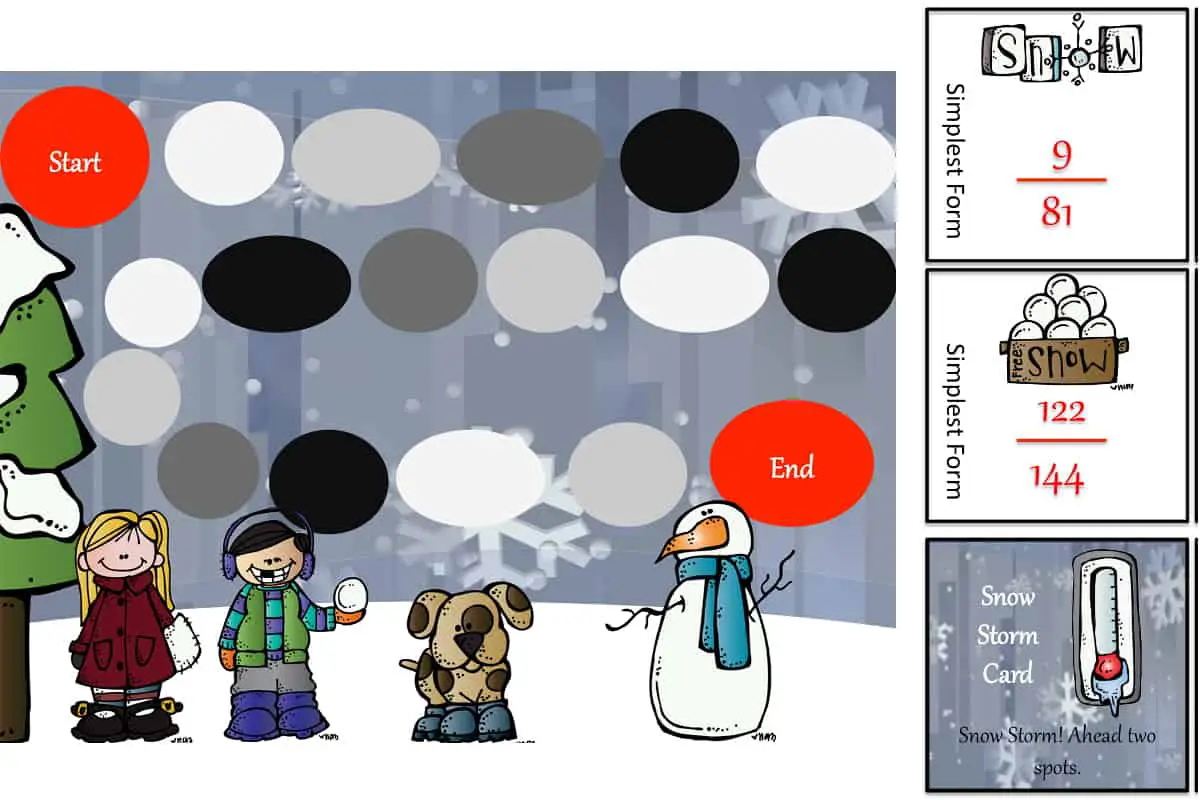
Players: 2 | Age: 7-10 | CCSS Grade: 2-4
One element of this game stands out the most; there are a few large numbers that will require a bit of thinking to determine the simplest fraction. This feature makes the game best suited for more advanced students in grades 2 to 4. It’s a game that gives them an appropriate level of challenge without causing them to feel overwhelmed.
stands out the most; there are a few large numbers that will require a bit of thinking to determine the simplest fraction. This feature makes the game best suited for more advanced students in grades 2 to 4. It’s a game that gives them an appropriate level of challenge without causing them to feel overwhelmed.
However, the game board is short and the questions are few. Therefore, students may probably finish the game within five to six minutes. Additionally, the game is very colorful and will, therefore, require a lot of ink.
Simply Ninjas – Equivalent Fractions, Simplifying Fractions (Rogue Algorithm)
★★★☆☆
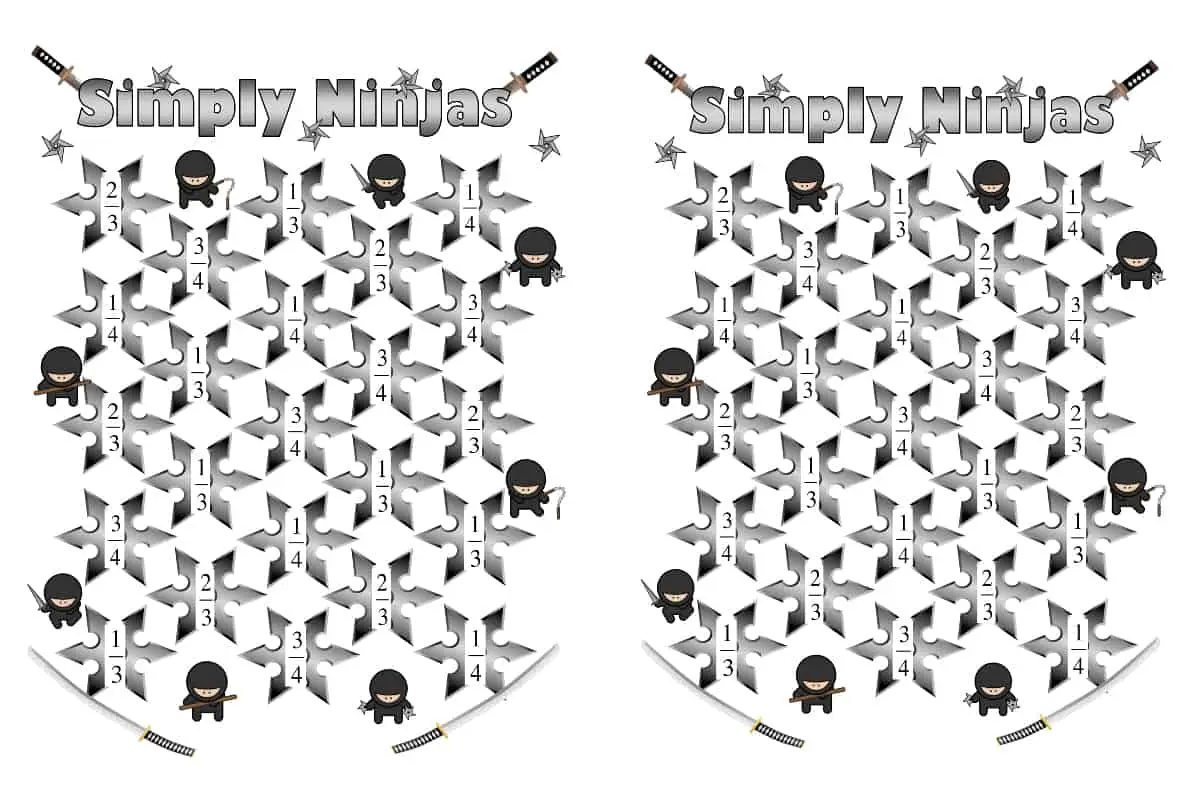
Players: 2 | Age: 9-12 | CCSS Grade: 4-6
Simply Ninjas combines the concept of equivalent fractions with simplifying fractions in a very deliberate way. There are four different game boards to provide differentiated learning. You can choose games based on the skill you want students to practice and how well they understand fraction equivalence. However, the fraction denominators range from three to six. Therefore, students don’t get as much practice as they need with larger numbers.
combines the concept of equivalent fractions with simplifying fractions in a very deliberate way. There are four different game boards to provide differentiated learning. You can choose games based on the skill you want students to practice and how well they understand fraction equivalence. However, the fraction denominators range from three to six. Therefore, students don’t get as much practice as they need with larger numbers.
Game boards A and C would be the ones you should use if you want to reinforce the concept of simplifying fractions. I view this game as one of quick thinking. After spinning the spinner, players have to quickly identify an equivalent fraction on the board. The aim is to be the first player to make a complete path on the board either from top to bottom or from left to right. Therefore, the player needs to find a fraction that helps achieve this objective in the best way possible.
I see this game as a way to begin a lesson on teaching equivalent fractions. It’s important for helping students see the link between both concepts. However, it may take students a bit longer to understand the rules of this game than it would take to understand the rules of other games mentioned in this article. Regardless, this interesting game design is worth the extra effort.
Other Fractions Related Printable Games
If you are interested in further teaching fractions with printable board games, check out my other posts:
- Adding and subtracting fractions: 11 Printable Board Games for Adding & Subtracting Fractions

- Multiplying and dividing fractions: 6 Printable Fraction Board Games for Multiplying and Dividing Fractions

- Equivalent fractions: 10 Printable Fraction Board Games for Equivalent Fractions
Or if you would prefer to get a “real” board game, 16 Fractions Board Games for Students at School and Home.
Edudingo.com is a participant in the Amazon Services LLC Associates Program, an affiliate advertising program designed to provide a means for sites to earn advertising fees by advertising and linking to Amazon.com. We also participate in other affiliate programs which compensate us for referring traffic.

